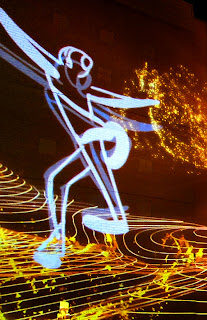Depth of field being the depth of sharp focus in front of and behind the point at which you focused when composing your shot. The smaller the taking aperture, the greater the depth of field. About one third of the depth of field is in front of the true focus point and about two thirds is behind that point.
Use a wide aperture, an f/stop with a small number, and the background in your shot will be rendered out of focus. This can make the subject of your picture, the think on which you focused, pop right off the page. It is a nice effect.
The small sensors in digital point and shoots make blurring background difficult. Depth of field is also dependent on the size of sensor, or with film cameras the size of the film. Cameras that used 4X5 film had very little depth of field. Back in the days of film, 35mm cameras were thought to give a lot of depth of field. Now, with sensors so small in many digital cameras, the 35mm cameras seem in comparison to have been great for blurring foregrounds and backgrounds. They made subjects pop from the image if you took the time to force the effect.
 |
| Usual look of a point and shoot picture of a flower in bright, full sunshine. |
Digital single lens reflex cameras, the top of the line ones with sensors the size of 35mm film, are great at reproducing the shallow depth of field of the old SLRs. But what to do if one is using a point and shoot with a small sensor. The answer: A photo enhancement program. I have found Photoshop does a great job of emulating the look resulting from shallow depth of field.
 |
| The flower picture taken into Photoshop to have the background blurred. |
So, how was it done? The pedals I wanted to remain sharp were selected using the magic wand. I also selected the flower immediately behind the main flower in order to keep them in focus too. I felt the traditional depth of field of the past might well have extended as far as that second flower in the image. I inverted the selection. I feathered the edgles about 2 pixels. Finally, I applied the Filter -> Blur -> Field Blur... until I got the look I desired.
Clearly, doing this in-camera is preferable. It is far quicker and the results are better if one simply shoots at a wide open aperture and then takes a couple of other pictures with the lens closed down an f/stop or two. But, if one doesn't have the money for a SLR and one can pick up Photoshop cheap - I did, keep an eye open for sales - then Photoshop, or another enhancement program with this blurring feature, may be the answer.
Clearly, doing this in-camera is preferable. It is far quicker and the results are better if one simply shoots at a wide open aperture and then takes a couple of other pictures with the lens closed down an f/stop or two. But, if one doesn't have the money for a SLR and one can pick up Photoshop cheap - I did, keep an eye open for sales - then Photoshop, or another enhancement program with this blurring feature, may be the answer.














